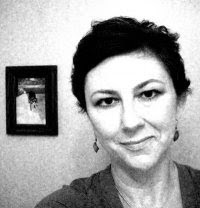Class Agenda for Friday, February 15, 2008
Morning: Meet in Overcash 151/call roll/turn in homework and Scarlet project (okay, some of you want to hold onto this until the last minute....must be into me by Wednesday, Feb. 20)

Morning: Meet in Overcash 151/call roll/turn in homework and Scarlet project (okay, some of you want to hold onto this until the last minute....must be into me by Wednesday, Feb. 20)

Demo: (Future Soup, left) Composition and still life;
We will work on a still life from an unusual point of view---from above, below, or an extreme close up. Points to remember about composition:
Open composition: active; gives the impression that the composition extends beyond the edge of the picture plane. Concentrate on movement, rhythm and texture. Work on creating realistic imagery, but moving the eye through the picture plane through abstract elements.
We talked about negative space and the symbiotic relationship of positive and negative space. In short, if your negative space isn't interesting, it's unlikely that your composition will be interesting.
We will work on a still life from an unusual point of view---from above, below, or an extreme close up. Points to remember about composition:
Open composition: active; gives the impression that the composition extends beyond the edge of the picture plane. Concentrate on movement, rhythm and texture. Work on creating realistic imagery, but moving the eye through the picture plane through abstract elements.
We talked about negative space and the symbiotic relationship of positive and negative space. In short, if your negative space isn't interesting, it's unlikely that your composition will be interesting.
The demo focused on blocking in shapes and color relationships. Beginners have a tendency to jump right into details without establishing a foundation for those details.
Students then completed a still life using colorful fruits and veggies.
Homework for Feb. 22.
 Painting I: Illustration Historically, artists like Albrect Durer (far left) used watercolor to “color in” their drawings. This usually means layers of color (allow them to dry in between) and precision---so, little or no wet-in-wet techniques. Much like illustrations seen over the years.(left)
Painting I: Illustration Historically, artists like Albrect Durer (far left) used watercolor to “color in” their drawings. This usually means layers of color (allow them to dry in between) and precision---so, little or no wet-in-wet techniques. Much like illustrations seen over the years.(left)
This should be postcard size or larger. Choose an object and reproduce it as faithfully as you possibly can. Try to be very objective in your representation. This will take some time; don’t wait until the day before to do it. (Clarification: Durer does introduce washes into his watercolors as well, which leads to the exploration of the spontaneous qualities of the medium, but you see this more in his landscapes.)
Possible subject matter: single flower, butterfly, insect, etc. Think images like botanical illustrations or Audubon.
 Painting I: Illustration Historically, artists like Albrect Durer (far left) used watercolor to “color in” their drawings. This usually means layers of color (allow them to dry in between) and precision---so, little or no wet-in-wet techniques. Much like illustrations seen over the years.(left)
Painting I: Illustration Historically, artists like Albrect Durer (far left) used watercolor to “color in” their drawings. This usually means layers of color (allow them to dry in between) and precision---so, little or no wet-in-wet techniques. Much like illustrations seen over the years.(left)This should be postcard size or larger. Choose an object and reproduce it as faithfully as you possibly can. Try to be very objective in your representation. This will take some time; don’t wait until the day before to do it. (Clarification: Durer does introduce washes into his watercolors as well, which leads to the exploration of the spontaneous qualities of the medium, but you see this more in his landscapes.)
Possible subject matter: single flower, butterfly, insect, etc. Think images like botanical illustrations or Audubon.
Painting II: Line and Wash

Artists like Paul Cezanne use line and wash to explore composition, color relationships, light references. Working about 8x10” or larger, combine the two mediums of watercolor and graphite to offer a subjective view of the subject of your choice. Line and color should play equal parts in the composition.
 This painting should be loose....limit your working time to about 45 minutes to 1 hour----no more!
This painting should be loose....limit your working time to about 45 minutes to 1 hour----no more!

No comments:
Post a Comment